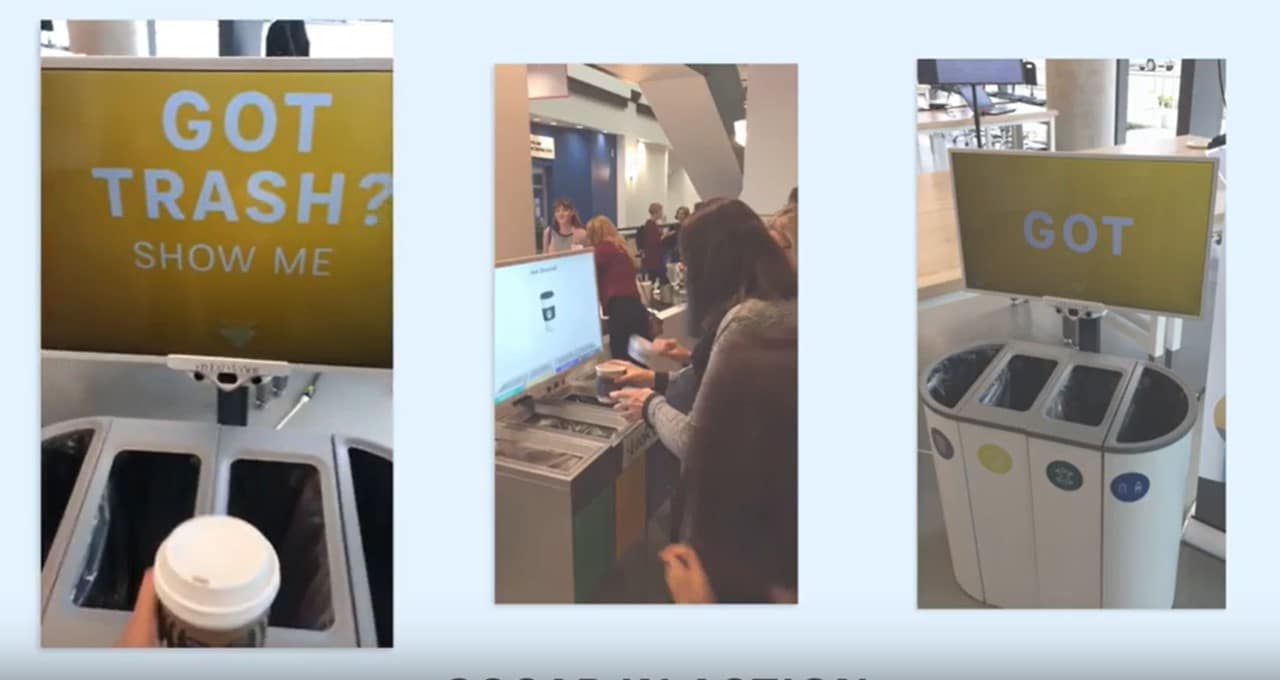Get ready for trash-talking garbage cans.
Hassan Murad and Vivek Vyas have developed the world’s largest garbage dataset, dubbed WasteNet, and offer an AI-driven trash-sorting technology.
The Vancouver engineers’ startup, Intuitive AI, uses machine learning and computer vision to see what people are holding as they approach trash and recycling bins. Their product visually sorts the item on a display to nudge the user how to separate waste — and verbally ribs people for misses.
The split-second detection of the item using WasteNet’s nearly 1 million images is made possible by the compact supercomputing of the NVIDIA Jetson TX2 AI module.
Murad and Vyas call their AI recycling platform Oscar, like Sesame Street’s trashcan muppet. “Oscar is a grouchy, trash-talking AI. It rewards people with praise if they recycle right and playfully shouts at them for doing it wrong,” said Murad.
https://www.youtube.com/watch?v=FYTrhtD182c&feature=youtu.be
Intuitive AI’s launch is timely. In 2018, China banned imports of contaminated plastic, paper and other materials for processing into recycling.
Since then, U.S. exports of plastic scraps to China have plummeted nearly 90 percent, according to the Institute of Scrap Recycling Industries. And recycling processors everywhere are scrambling to better sort trash to produce cleaner recyclables.
The startup is also a member of NVIDIA’s Inception program, which helps startups scale markets faster with networking opportunities, technical guidance and access to training.
“NVIDIA really helped us understand which processor to try out and what kind of results to expect and then provided a couple of them for us to test on for free,” said Murad.
The early-stage AI company is also a cohort of Next AI, a Canada-based incubator that guides promising startups. Next AI gives startups access to professors from the University of Toronto, Harvard, MIT and big figures in the tech industry.
In January, NVIDIA and Next AI forged a partnership to jointly support their growing ecosystems of startups, providing AI education, investment, technical guidance and mentorship.
Turning Trash Into Cash
Trash is a surging environmental problem worldwide. And it’s not just the Great Pacific Garbage Patch — the headline-grabbing mass of floating plastic bits that’s twice the size of Texas.
Now that China requires clean recyclables from exporters — with no more than 0.5 percent contamination — nations across the world are facing mounting landfills.
Intuitive AI aims to help cities cope with soaring costs from recycling collection companies, which have limited markets to sell tons of contaminated plastics and other materials.
“The way to make the recycling chain work is by obtaining cleaner sorted materials. And it begins by measurement and education at the source so that waste management companies get cleaner recyclables so that they can sell to China, India,Indonesia or not send it at all because eventually, we could be able to process it locally,” said Murad.
Garbage in, Garbage out
Deploying image recognition to make trash-versus-recycling decisions isn’t easy. The founders discovered objects in people’s hands are often obscured 80 percent from view. Also, there are thousands of different objects people might discard. They needed a huge dataset.
“It became quite clear to us we need to build the world’s largest garbage dataset, which we call WasteNet,” said Murad.
From deployments at malls, universities, airports and corporate campuses, Oscar has now demonstrated it can increase recycling by 300%.
WasteNet is a proprietary dataset. The founders declined to disclose the details of how they created such a massive dataset.
GPUs Versus CPUs
The startup’s system needs to work fast. After all, who wants to wait by a garbage bin? Initially, the founders used every possible hardware option on the market for image recognition, said Murad, including Raspberry Pi and Intel’s Movidius.
But requiring that people wait for up to six seconds — the result of their early hardware experiments — for where to toss an item just wasn’t an option. Once they moved to NVIDIA GPUs, they were able to get results down to half a second.
“Using Jetson TX2, we are able to run AI on the edge and help people change the world in three seconds,” said Murad.
